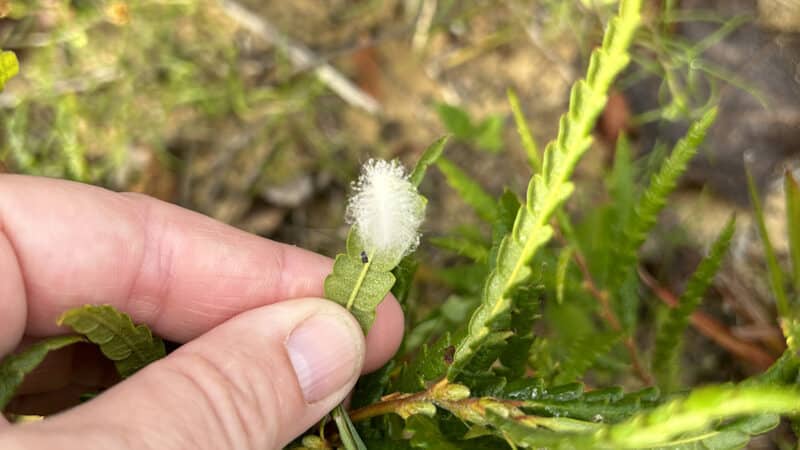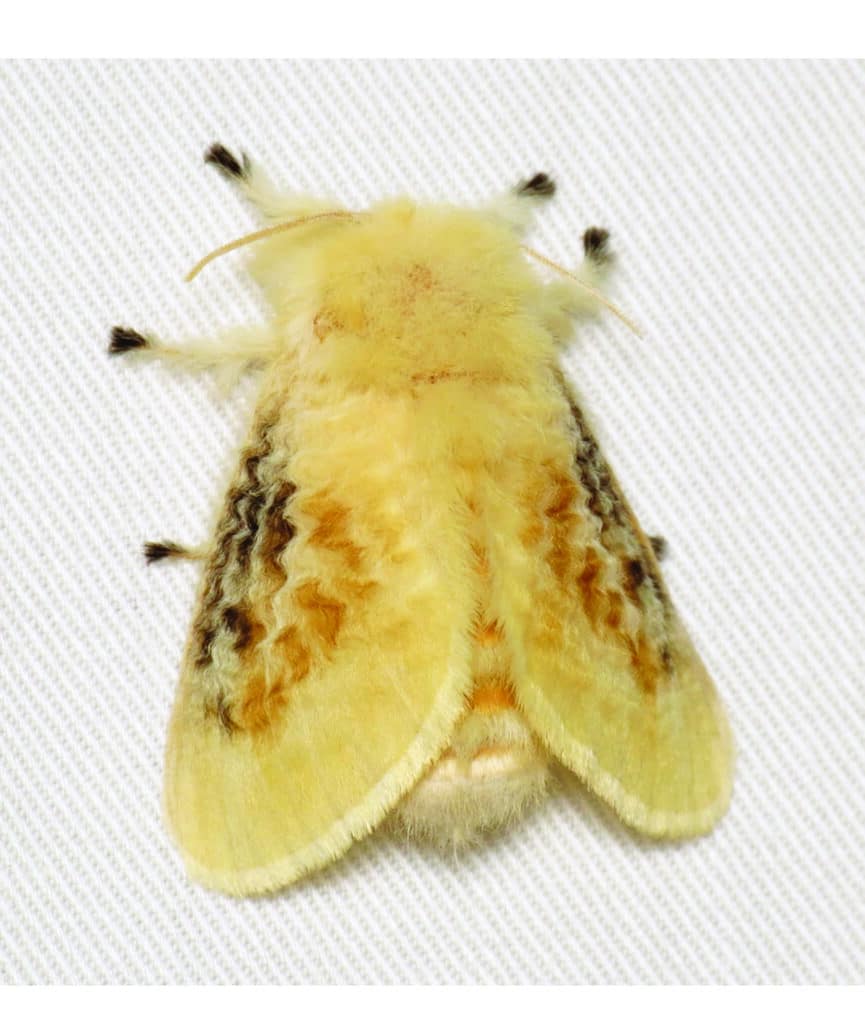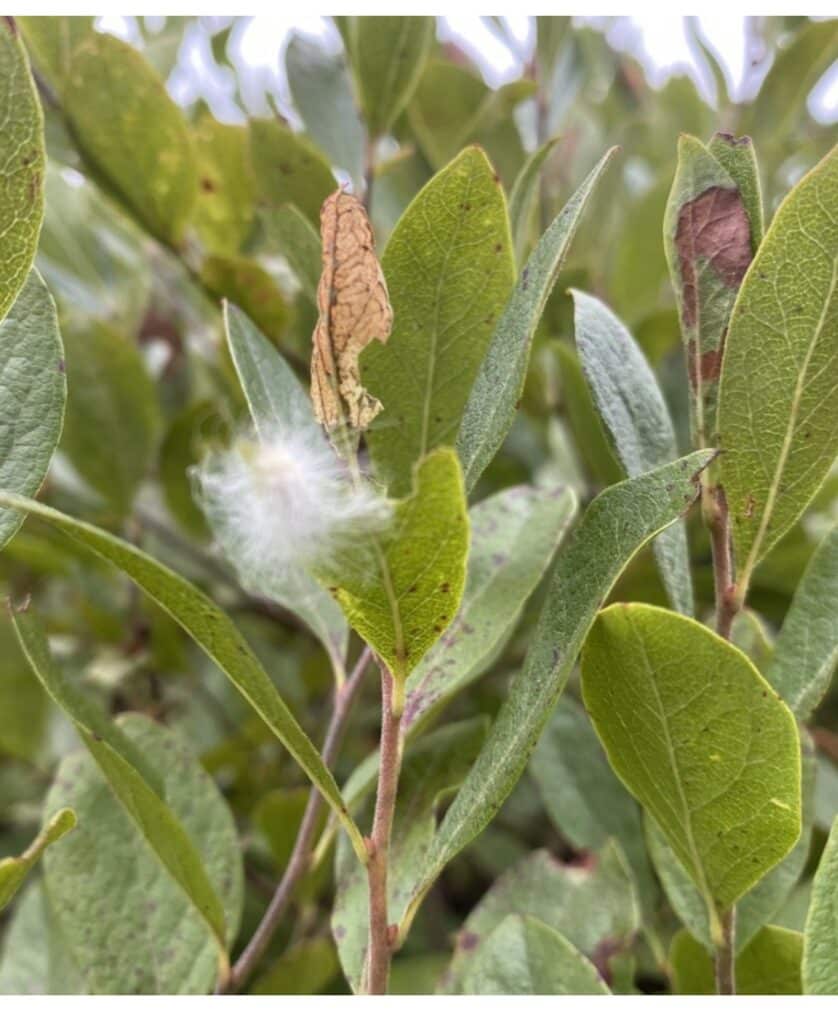by Dr. Sarah Treanor Bois, PhD
Director of Reseach & Education at the Linda Loring Nature Foundation
Back in 2005, when I was a field assistant with the Nantucket Conservation Foundation, I spent many days in the heathlands on my hands and knees recording vegetation—an integral part of our research. One early fall day, as I placed my hand on the ground, a severe pain generating from the palm of my hand pulsed up through my arm. Looking back at the spot where my hand had been I expected to see a shard of glass or a giant rose thorn. None of the above. I had just squished a puss moth caterpillar with my palm.
Puss moth caterpillars, or flannel moths (Megalopygidae family), are described as one of the most toxic caterpillars in North America. They appear soft and harmless, and are often described as “wispy cotton” or “fur balls on leaves.” Despite their innocuous appearance, they can pack a punch! According to Caterpillars of Eastern North America by David Wagner, beneath the soft outer hair are hollow, poison-filled stinging spines that can deliver a pretty painful sting. When the caterpillar rubs or presses against skin, the venomous hairs can become embedded.
Flannel moths can be seen right now on Nantucket in one of its early caterpillar stages, when it looks like a cute tiny backside of a rabbit. These caterpillars are more often found in the North American south, but there are three species found farther north. On Nantucket we have Megalopyge crispata, the black-waved flannel moth, which is often found in the heathlands and shrublands of the outwash plain. They feed on a number of plants, but I’ve seen them most frequently on black huckleberry and bayberry.
Black-waved flannel moths are found as far north as New Hampshire, but are more predominant along the New England coast. Wagner describes coastal fields and meadows as particularly productive. I can attest to that, having seen them glisten with dew in the morning as they hang out in fields of black huckleberry.
How is it so toxic? The caterpillar defends itself from predation with its guard “hairs” which are hollow structures carrying venom. The hollow poison-filled stinging spines can act like tiny poison darts. The longer setae hairs curl at the ends and look like animal fur. For people, the venom can penetrate the skin causing itching and burning on the site as well as sharp pain. Exposure can also cause headaches and nausea. While they won’t kill you, they can pack a punch. Reaction stings can be severe, but the majority of people will only feel an irritation akin to a bee sting lasting about an hour. More susceptible patients can experience swelling, nausea, abdominal pain, headache, shock, and even respiratory distress. The severity of the sting can also vary with the thickness of the skin where the sting occurs. In his book, Wagner describes working with specimens in his caterpillar collection and inhaling some hairs. The irritation, burning, and swelling escalated to a point where he checked himself in to the local hospital. After an hour or so, the symptoms subsided and he was free to go.
As for me? Well, with numbness and swelling travelling up my arm, I was rushed to the hospital by my co-workers. Apparently, I am not only sensitive to the stings, but by squishing it with my palm, I had the full amount of toxin delivered to one of the most sensitive spots on the body. The staff at the Nantucket Cottage Hospital had never heard of puss moth caterpillars. They thought it must have been a bee sting, despite my protests. Two Benadryl and a few hours of sleep later, I was good as new.
While they can be a nuisance, flannel moths are a native species. They are generally kept in control by natural predation. Pretty soon they will mature to a point where they are ready to metamorphose. They overwinter in their cocoons which are often spun around the base of a food plant. They emerge in spring as adult moths. The common name “flannel moth” is due to the thick coating of fur-like setae on the moth body and legs which is predominantly yellowish- white.
This time of year, late summer, they appear as white cotton balls. Later, as they consume more vegetation, they will grow darker and less wispy, resembling a tiny tribble. Because of this cuteness factor, it would be wise to advise children about them so they do not pick them up.
So, what should you do if stung by a puss moth caterpillar?
- Wash the skin with soap and water.
- Use local cooling like an ice pack to reduce pain and swelling.
- Rub the area with an alcohol swab.
- Putting tape on the site and then ripping it off can remove the embedded hairs.
Puss caterpillars may be one of the most toxic of species found here, but they still have nothing on ticks.





